Music Commissions Home | Music Commissions Brief History | Music Commissions Articles List | Composer's Guide to the Piano Accordion
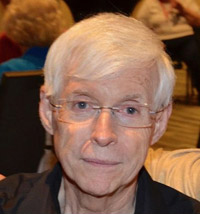
1959 was the second busiest year to date (1960 being the first) for the AAA Composers Commissioning Committee. In that third active year of the Committee's history, Chairperson Elsie Bennett successfully offered five contracts to that many of America's leading composers: Virgil Thomson (whose Lamentations was explored in the 1999 issue of the AAA Festival Journal), Carlos Surinach, Robert Russell Bennett, Henry Cowell, and William Grant Still. The middle three composers and their accordion works will be discussed in this article.
The acclaimed Spanish composer Carlos Surinach was born in Barcelona in 1915 and died in New Haven, Connecticut in 1997. He was educated in the Conservatory in Barcelona and later in Berlin, where he studied with Max Trapp and Richard Strauss. In 1951, after an active conducting career throughout Europe, he emigrated to the United States and settled in New York. He became a citizen in 1959, the year of his AAA commission. Principally noted for his ballets, he was between commissions for Martha Graham's renowned New York dance company (Embattled Garden, 1958, and Acrobats of God, 1960) when he signed his AAA contract on June 11.
In the January 1960 issue of Accordion and Guitar World, Elsie Bennett reported that Surinach had accepted the commission with much enthusiasm, stating that the accordion has "so many colors and resources" and is "easier to use your imagination when writing for it." He also declared that he intended to "write this number accordionistically" and further complimented the instrument, proclaiming that it had “much more dynamics than the organ because it has more nerve and drive, and is more human ... [and] can produce accents in a way that the organ cannot, and it seems to have the animal pulse." The resulting piece was Pavana and Rondo.

Carlos Surinach and Elsie Bennett, 1959. Elsie Bennett photo album. |
Typical of Surinach's style and cultural background, the work is decidedly of Spanish flavor, utilizes the octatonic "Flamenco Scale" of alternating half and whole steps (C-sharp, D, E, F, G, A flat, B-flat, B, as stated in the article) at times, and is only mildly dissonant (due mostly to occasional polychords). As its generic title implies, the composition falls into two movements, “Pavana” and “Rondo,” with respective tempo assignments larghetto and allegro.
As an historic musical form, the pavana (pavan, pavane, padovana, Paduana) is a slow, dignified, processional or “couple” court dance in triple meter that has its origins in early sixteenth-century Italy. Its original function was to accompany dancing couples in a sort of ritualistic procession of greeting to enthroned royalty. Other than employing modern harmony, Surinach’s adaptation of this stylized dance is of that formal character and entirely in 3/8 time.
It is interesting to note that Surinach employs the accordion idiom of bellows shake to a considerable degree in this movement. However, he does not apply it in the usual highly rapid, showy “unmeasured” style so often encountered in flashy accordion novelties, but rather in clearly notated or inferred rhythms, the treatment of which in bowed string music is termed “measured tremolo.” This is in opposition to rapid “unmeasured tremolo,” in which the exact notation is not supplied but left up to the performer within the time limit of a single printed note value whose stem is usually struck through by two or more diagonal dashes. What the bow does in string music the bellows do in accordion repertoire, as may be observed in both movements of Surinach’s piece. See measures 1, 2, and 5 of Example 1, measures 1-4 of Example 3, and measures 5, 6, and 7, of Example 7.
The Pavana begins with a quiet, but bold, rather stanch homophonic theme, shown in its entirety in Example 1.
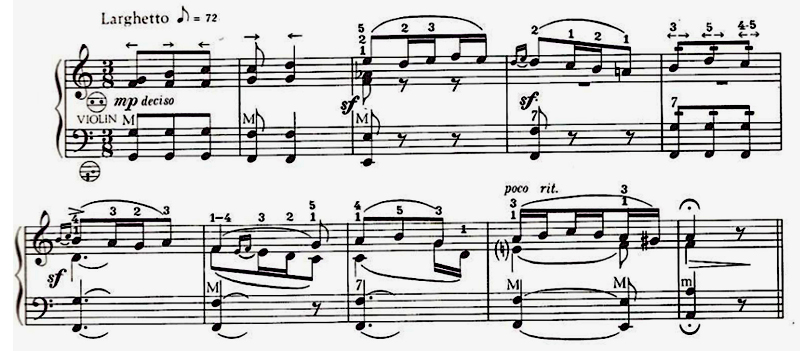
Example 1. Beginning and theme 1 of the Pavana, including “measured” bellows shake in measures 1, 2, and 5 |
Following is the far lengthier second section (25 measures) of the movement whose persistent main motif is comprised of two eighth notes followed by a dramatic, flourishing 32nd-note septuplet. See Example 2.
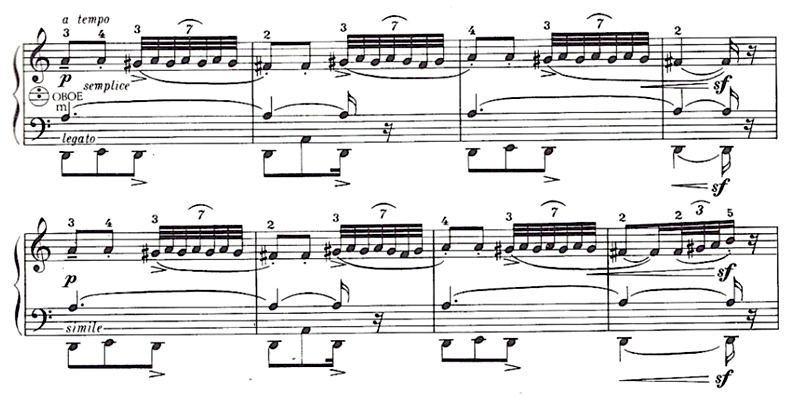
Example 2. Beginning of second main theme of the Pavana, measures 11-18. (Entire section ends at measure 39.) |
This persistent dirge is interrupted only once after 25 measures by a four-measure, bellows shaking, rising and falling scale consisting of eleven of the twelve notes of the chromatic gamut and dissonated in varying degrees by left-hand chordal buttons and some harmonically added right-hand lower notes. This momentary escape returns to thirteen more measures bearing the original opening rhythmic motif. See Example 3.
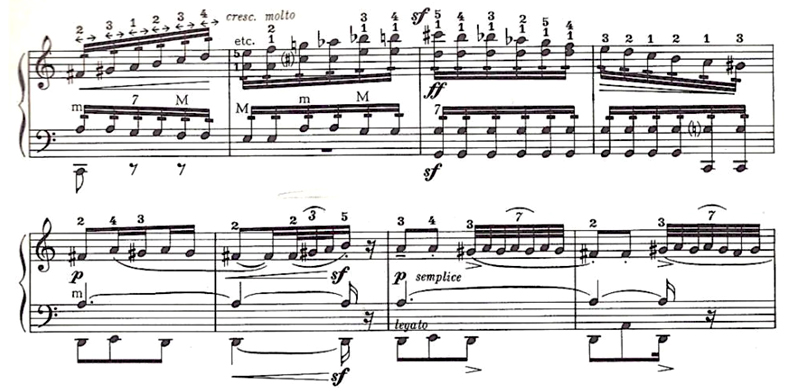
Example 3. Brief four-measure scalar interlude, with rapid “measured” bellows shake (in which each 16th note becomes two repeating 32nd notes) in first four measures and return of main “dirge” melody in the seventh and eighth measures. Measures 19-26. |
At measure 40 the opening theme returns in the bass while the right hand adds rapid, heavily chromatic, but often momentarily interrupted, streams of accompanying 32nd note scales (often following the pattern, or parts of the pattern, of the earlier described “Flamenco scale”) and arpeggios. Following this virtuosic twelve-measure rendition of the theme is yet another repetition of it, but this time as a simpler, homophonic, and exact return of the original opening version, only transposed a perfect fifth higher and ending with a more flourished final cadence measure.
The Rondo is less severe and formal than the Pavana, with a flowing line mostly in 9/8 time, though often interrupted by striking moments of hemiola (abrupt metrical shifts between 3/4 and 6/8 or 9/8 time, again, typically Spanish). It is also merrier than the Pavana, being cast mainly in a major key, despite the many instances of the somewhat darker and chromatic Flamenco scale employed in rapid runs (an instance of which appears on the first beat of measure 3 in Example 4).
As is expected in a rondo, there will be returning themes, which in this work form the following pattern: A/B/A/C/D/C/A/B/A, extended into a coda.
See Example 4 for the A theme.

Example 4. Beginning of the opening “A” theme of the Rondo. Measures 1-4. |
The eight-bar B theme carried in the right-hand keyboard consists mostly of unbroken runs of 16th notes built on the Flamenco scale. The left-hand bass part sounds in immediate counterpoint with it, first restoring the A theme but, after three measures, giving way to strongly accented oom-pah-pah chordal buttons in groups of three eighth-note values that create free dissonances with the highly chromatic right-hand part. See Example 5.
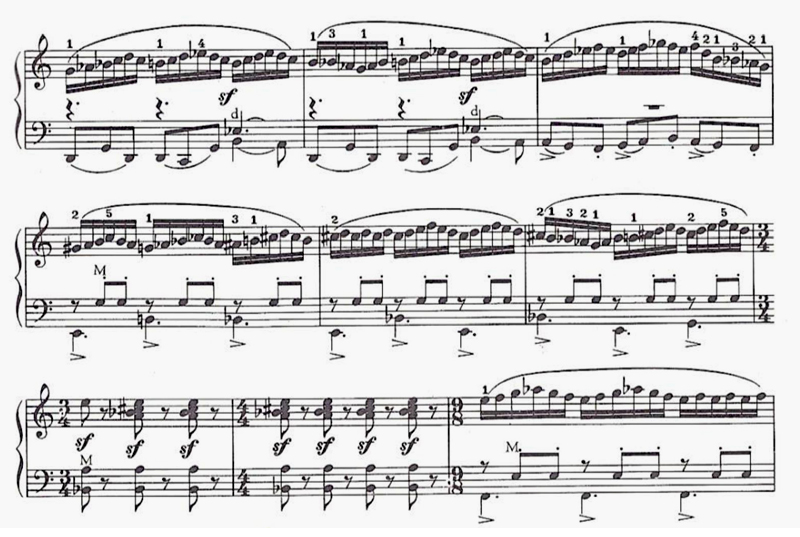
Example 5. Beginning of the B theme of the Rondo. Measures 5-13 |
After the return of the slightly altered A theme in measures 13-19, the suave C theme enters, softened by the employment of the muted, smooth timbre of the right-hand Clarinet switch. The alternation of 6/8 and 3/4 meter gives a gentle “bump” to this pleasant middle section of the movement. See Example 6.
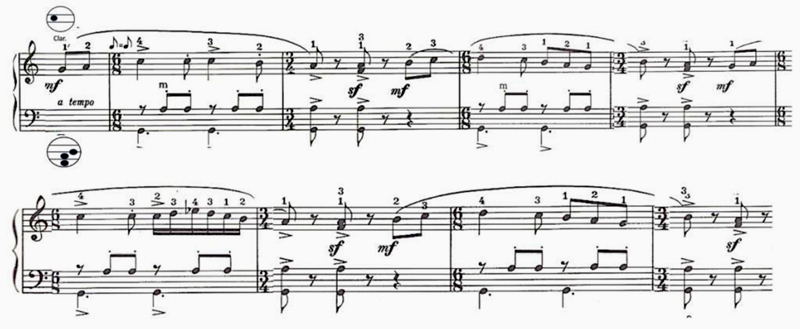
Example 6. Beginning of C section, measures 19-27 |
This eight-measure melodic oasis anchored on a persistent G pedal point in the low bass part, moves directly into an equally engaging, similarly constructed chordal section I will designate as section D, also eight measures long, including bellow shakes in its second half. The soft clarinet register is now replaced by the louder and rowdier master shift. The left hand baritone stop likewise shifts to the maximum power and aural weight of its master shift. See Example 7.
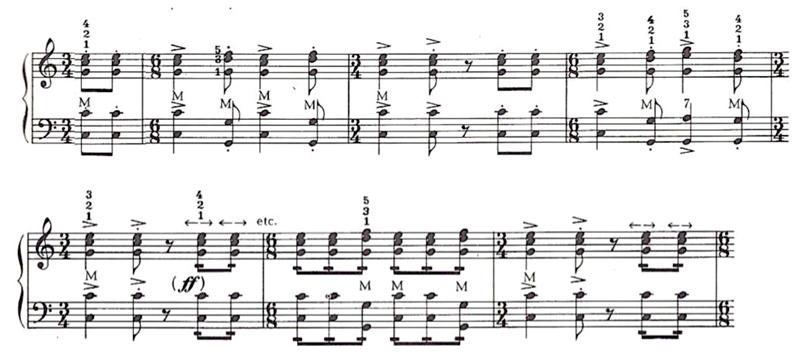
Example 7. Beginning of D section, measures 27-33. |
The C section returns at measure 35 little altered except for 1) a switch in the right-hand part from the former Clarinet register to that of the even smoother sounding, though darker, Bassoon, thus also causing the melody to aurally drop an octave; and 2) an unbroken, more active, syncopated left-hand sixteenth-note accompaniment that drives the melody forward more aggressively than before.
Following this the expected return of sections A, B, and A again dutifully takes place, somewhat altered but clearly recognizable and in approximately the same lengths as before. The last of these, however, segues into a driven eleven-measure coda, the last four measures of which comprise one final, emphatic statement of the A theme prior to its abrupt cadence on a hollow G triad lacking its 3rd.
Pavana and Rondo was published by Capri Music Corporation (with Alfred Music holding sole selling rights) in 1959.
Missouri-born Robert Russell Bennett (1894-1981; no relationship to Elsie Bennett) is most remembered for his masterful orchestrations of an impressive number of major Broadway musicals by such stellar American icons as Jerome Kern, George Gershwin, Cole Porter, Richard Rodgers, and Irving Berlin, and for bringing that aspect of musical craft to a level of high status in his profession. Several his own compositions reflect the influence of Broadway as well, his Four Nocturnes for accordion (the sixth AAA commission) certainly being one of them.
The correspondence between Elsie Bennett and the composer (which, interestingly, goes back to 1953) reveals that he began and completed this commission sometime between December 1958 and June 1959. There is no contract date because the composer generously refused financial compensation for this service. The correspondence also reveals that the two Bennetts were already discussing a second commission, this time for accordion and string quartet, which, in fact, did eventually transpire in1962 as the twenty-second AAA commission (originally discussed in the 2009 issue of the AAA Festival Journal, updated and expanded in 2022 and available on the AAA website).

Elsie Bennett and Robert Russell Bennett, Elsie Bennett home, Brooklyn, New York, March 11, 1959. Elsie Bennett photo album. |
Following Elsie Bennett's adding fingering to the manuscript, the Four Nocturnes was published by Chappell shortly after the composer reported to her that he had finished his Commemorative Symphony Based on Stephen Foster (letter of June 23, 1959). More momentous surrounding accomplishments of the composer at that time, however, were his orchestrations of Flower Drum Song (1958), The Sound of Music (1959), and Camelot (1960).
Though Bennett was very appreciative of accordion information materials sent to him in 1957 by Elsie Bennett, he revealed in a 1953 letter to her (from which she quotes in her feature article on him and the commission in the February 1960 issue of Accordion and Guitar World) that he had been using the accordion "a great deal, in small combinations" all his life. Like Surinach, he made comparisons between it and the organ, saying it was more "flexible" than the organ and that one could “get a sforzando on [it] on one note," unlike on the organ.
The four movements were given the following tempo designations: 1. Moderato alla serenata, 2. Un piu blu, 3. Lento e pianissimo, and 4. Allegro.
The first movement, Moderato alla serenata, is reminiscent of a sensuous nineteenth-century nocturne in its beginning moderato section, which lasts for 35 measures. See Example 8.
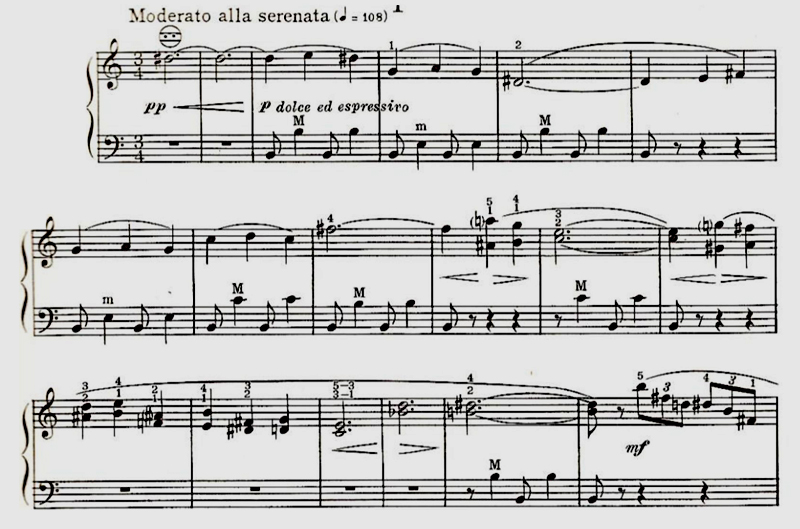
Beginning of the first movement of Four Nocturnes. |
A second, quite contrasting section, marked Poco scherzando, abruptly abandons the serene mood of the “serenata,” and swings in the sultry manner of the "Great White Way" as if there has been a sudden scene change in a Broadway musical. See Example 9.
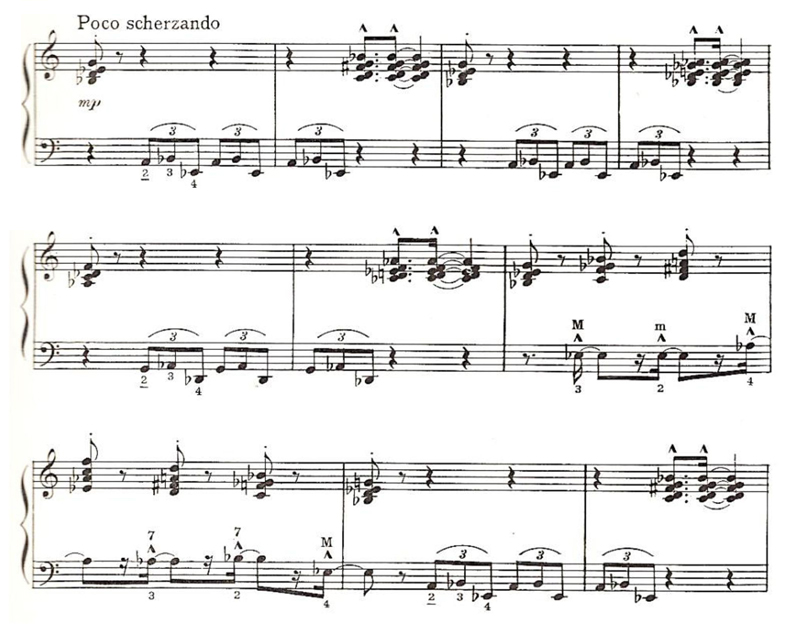
Example 9. Livelier middle section of the first movement of the Nocturnes, measures 36-45, prior to the much-shortened return of the opening theme at measure 55.> |
This brassy middle section lasts for nine measures before settling down to a much-truncated return of the serenata and restored tranquility.
The second movement, also swings, but in a more relaxed, easy-going manner typical of the blues in music (as its tempo marking, Un poco blu, “a little blue,” suggests), featuring a lazy dotted-note figure surrounding single returning pitches supported in the bass by a series of characteristically bluesy major-minor 7th chords following the descending circle of fifths (easily attained on the “quint” arrangement of the stradella left-hand system). See Example 10.
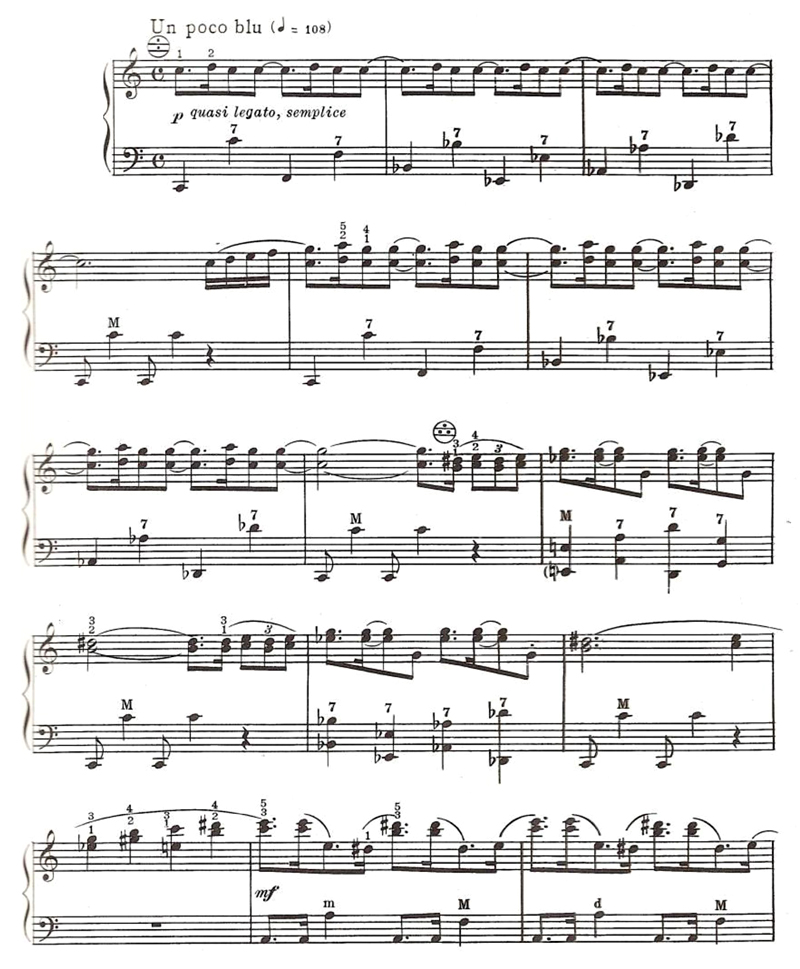
Example 10. Beginning of first of two major sections comprising the second movement of the Nocturnes. |
After a dramatic series of rising triplets at measure 19, the mood becomes more brash and extroverted while introducing a new, almost crooning melody of more prolonged note values that is nonetheless prodded along by the dotted values of the bass accompaniment heard so frequently earlier in the movement. See Example 11.
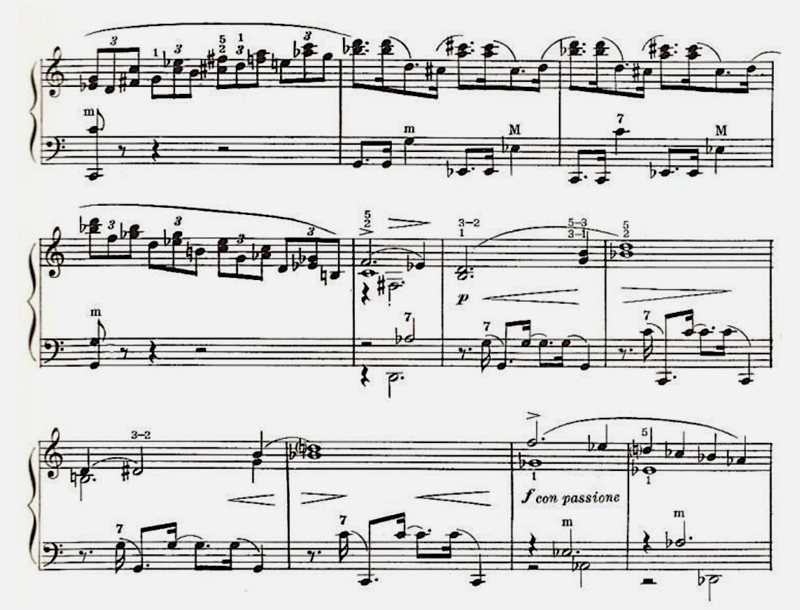
Example 11. Measures 19-29. Dramatic moments in the second movement of the Nocturnes and introduction of a more song-like, less rhythmically “jerky” theme (beginning at measure 24). |
Things eventually quiet down, however, during the final third of the movement which restfully cadences on a fading tonic C-major 9th chord (again, a not uncommon final cadential chord quality in blues music).
The considerably morose third movement (Lento e pianissimo) is essentially a minor-key sarabande, caste in that old dance form’s tradition in a stately, trodding triple meter. Its melody is highly ornamented by many thirty-second-note passages against a persistent dirge-like left-hand accompaniment. Taking most of the melody and left-hand accompanimental chordal button choices by the composer in mind, it may be argued that the movement is predominantly conceived in the E-Dorian mode (E-F#-G-A-B-C#-D). See Example 12. Ever interested in tonal color (not surprising for the masterful orchestrator this composer was), Bennett has changed the right-hand register at the beginning of each phrase.
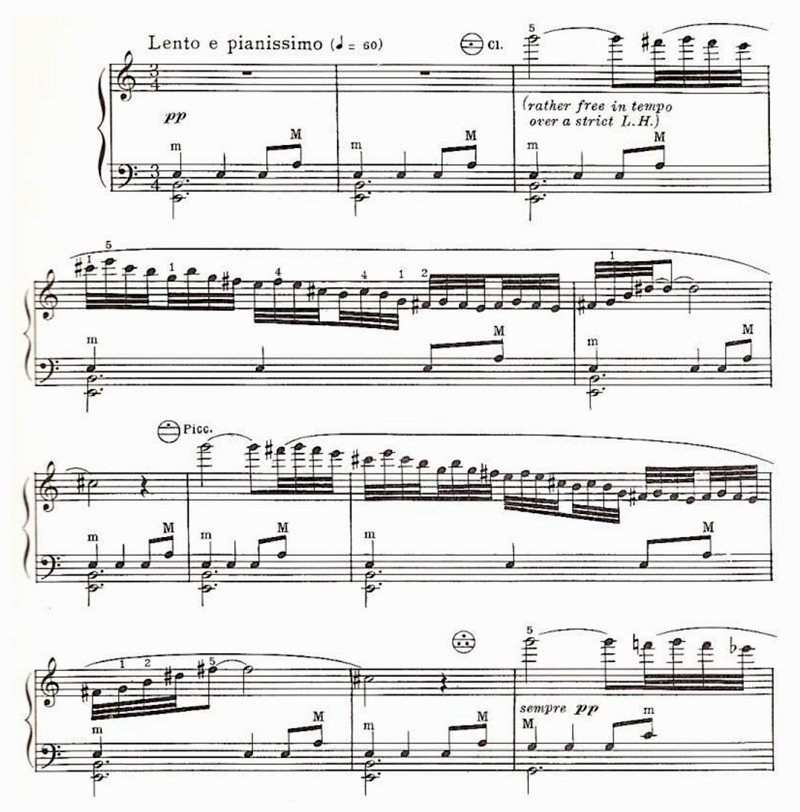
Example 12. Beginning of the third movement, Lento e pianissimo, of the Nocturnes, with right-hand registral changes at the beginning of each phrase (measures 3, 7, and 11) for “orchestral” color. In addition, the piccolo register will elevate the second phrase (measures 7-10) an octave higher than written. |
The closing movement (Allegro) is a mischievous rondo of sorts in D minor, dominated by fast moving harmonic fourths at the outset. This main melody recurs in altered form four times between various transitions and at least one strongly contrasted two-section theme in the middle of the movement. See Example 13 for the initial version of the main (“A”) theme.
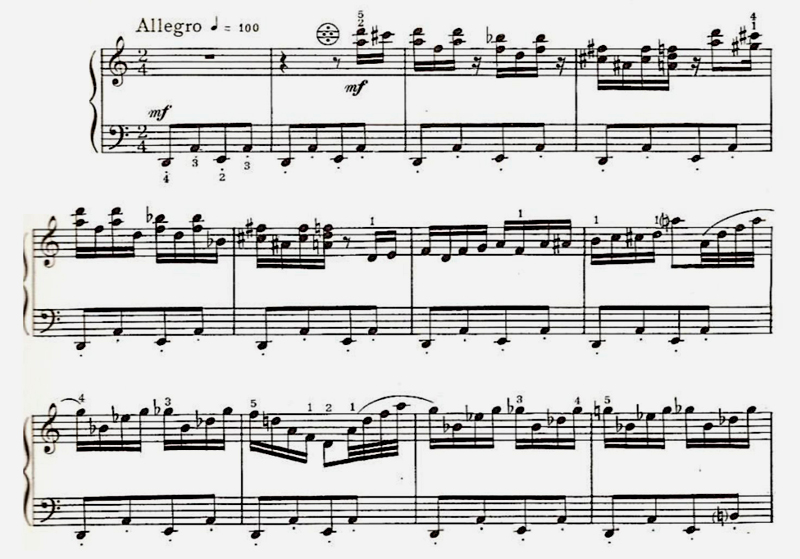
Example 13. Initial version of returning “A” theme of final Allegro movement of the Nocturnes, measures 1-12. |
Following 45 measures of development of these materials a rowdy second section consisting of a brief eight-measure syncopated chordal passage, again in the tradition of Broadway, leads into a second principal section that could easily serve as theme music for a 1950s television Western series. See Example 14.
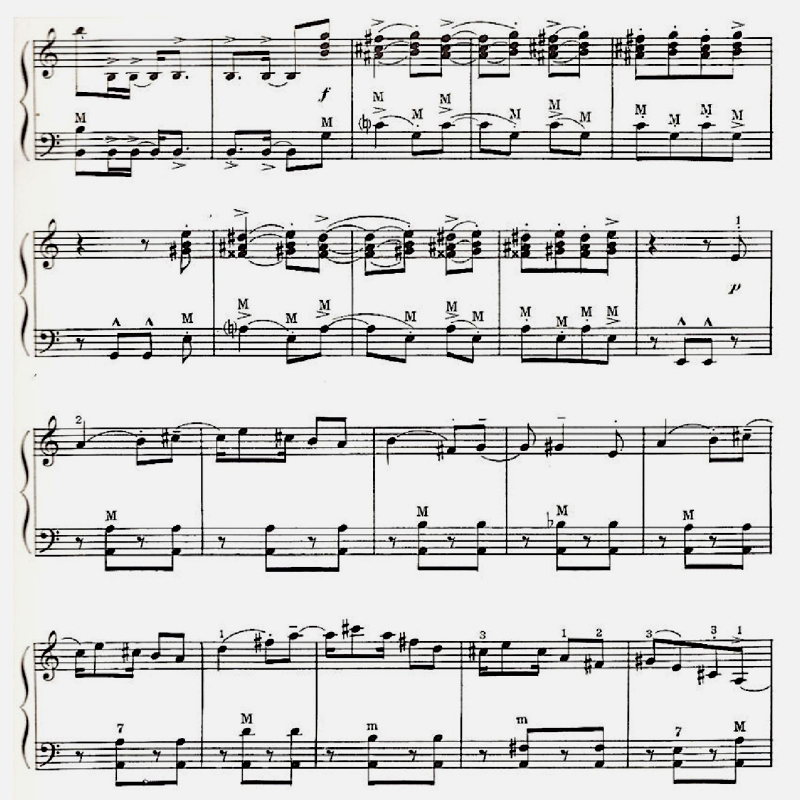
Example14. Middle melodic group of Allegro movement, measures 45-64. End of glitzy transitional chordal section (measures 45-48) leading to rodeo-like theme (beginning at measure 49). |
After 38 measures’ unfolding and development of this section and a truncated return of the opening melodic material of the movement, a kind of show-ending, high-kicking strut that one might imagine as the last dance number at Radio City by the Rockettes (at the Maestoso marking in the score) brings the movement and the entire Nocturnes to a flashy end. See Example 15.
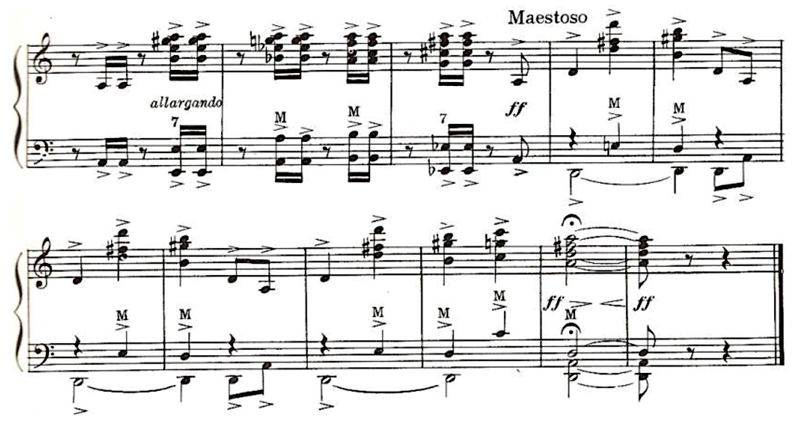
Example 15. “Strutting” Broadway-style coda of fourth movement, measures 100-110 |
All four movements do somehow succeed to be sensual, nocturnal pieces even if occasionally, and very cleverly, invaded by the glitter and, at times, noisy brassiness, of the American musical theater that was so much the center of Bennett’s professional career. A fun work for both listener and performer.
Of the three twentieth century composers represented in this writing, Henry Dixon Cowell (1897-1965) is the only one possessing a musically radical past (not to mention a very complex, complicated, and broadly varied life story, on both personal and professional basis). This highly prolific, stylistically pragmatic, California-born figure, is ranked with four other first generation American avant-garde composers now known collectively as the "American Five." They were Charles Ives, Carl Ruggles, Wallingford Riegger (who the reader will recall was also commissioned by the AAA*), and John Becker. All flourished in the first half of the twentieth century and were the first to draw worldwide attention to America's first truly modernist musical movement.
Cowell is particularly noted for his startling experiments with the piano around the middle of World War I through the 1920s, a highly experimental, diverse, and daring era in virtually all genres of music, both “popular” (including jazz and, it must be said here, the rise of the accordion’s popularity in Vaudeville) and “classical.” These include Cowell’s invention of the "tone cluster" (dissonant chords created with the palm of the hand or the forearm) and playing inside the piano through plucking, strumming, striking with various objects, and sliding across the strings (the latter most notably represented in his 1925 piano solo, The Banshee). By 1936, however, his interests turned to increasingly more traditional practices, so that by the time he accepted his AAA commission (contract dated July 14, 1959), he had long been using very regular rhythms and fairly traditional melodic lines and harmonies, often in a folk-like style. In fact, his resulting Iridescent Rondo for accordion is built on the old Church modes and freely applied triads, devices that had become out of date decades earlier. (A later AAA commission, his Concerto Brevis, for accordion and orchestra, was to use this musical language as well.) That said, Cowell does momentarily employ some right-hand tone clusters in a few passages of Iridescent Rondo, though not to the degree he would have done in his younger experimental days.
Baby-boomer era accordionists pursuing professional degrees in composition and theory in various music schools and departments during the third quarter of the twentieth century, and tending in their original works to follow the then fashionable atonal trends of Schönberg and his followers, would have preferred that Cowell had made his contribution to their instrument in the 1920s, when he was not afraid of adventurous and often dissonant experimentation, instead of his later years, in mid-century, when his style became very tame and quite conventional in general effect. They would have to wait another two years, in 1962, for more current directions in modern accordion repertoire to arise when Ernst Krenek composed his brilliantly innovative and highly idiomatic Toccata for the AAA (the twentieth commission), the first essentially atonal work to represent the committee's endeavors up to that time.
In her article in the January 1961 issue of Accordion and Guitar World announcing the publication of Iridescent Rondo, Elsie Bennett recalled that she had been in touch with the composer as early as 1952, hoping that he would accept a commission from the AAA. At first, she reported, Cowell was somewhat discouraged by the fixed-chord buttons of the 120-bass left-hand system, but after he saw that such a perceived limitation did not prevent Wallingford Riegger, Paul Creston, Virgil Thomson, and Surinach from ably tackling the instrument for the AAA, he finally decided to accept the offer. She further wrote that he declared his liking the accordion tone "principally as a solo instrument, as it is one in which the dynamics can be controlled," and that the "number will be lyrical, not too modern, and not too conventional. It will have contrasting rhythms."

Elsie Bennett and Henry Cowell. Bennett Brooklyn home. August 16, 1961. Bennett photo album. |
Few, if any, of the AAA commissioned composers have given a more thoroughly analytical description of their accordion works than did Cowell for his Iridescent Rondo. Like the professor he had become in his midcareer (at such leading American music schools or departments as Stanford University, the University of Southern California, Mills College, Peabody Conservatory, Columbia University, and New School for Social Research), he gave a virtual lecture on the inside cover of the Momac publication of the piece, worth fully quoting here (displayed in his original indentations and capitalizations):
In old modes Written for American Accordionists’ Association, August 1959 By Henry Cowell Time: about 5:20 tone which differs from the major or minor scale, and in order to harmonize, chords which are simple but unexpected are often used; rarely tonic and dominant. B theme, Lydian mode on E flat A theme, Dorian mode on C C theme, Mixolydian mode on F A theme, Ionian mode (same as major scale) on F D theme, Aeolian mode on D A theme, Dorian mode on A B theme, Lydian mode on D C theme, Dorian mode on A D theme, Aeolian mode on D A theme, Dorian mode on C. |
The work therefore turned out to be an eleven-part rondo in which the beginning and ending A theme occurs, not uncommonly for the form, more often than the others at, in this case, five times, while the others (B, C, and D) only twice
In the Accordion and Guitar World article, he further stated “I hope and think it is something that requires virtuosity, but not a new kind of technique. It is a show-off piece which runs along between allegretto and presto."
The main A theme presents a kind of urgent moto perpetuo motif of sustained dotted eighth- and sixteenth-note figures accompanied by rapid sixteenth notes, and in 4/4 time. The intervening themes (B, C, and D) offer clear contrasts to the main theme and each other while keeping the rapid motion going. The resulting overall effect is like that of a vaudevillian accordion novelty. (In fact, Cowell reported that he had heard Pietro Deiro on the stage many times in his younger days.)
The following chart will display beginning excerpts of all the sections of the Iridescent Rondo and their features. One throwback to Cowell’s younger, more experimental days of the 1920s is the inclusion of right-hand tone clusters (as described above) that occur briefly in a few places, one of which appears in one of the examples below and is labeled in red.
Descriptive comments will accompany each section of the work and will be arranged in the following order before each excerpt is displayed in musical notation:
Section letter (with numeration I have added to distinguish between changed or unchanged states of sections’ returns) / measure number range / right-hand register(s) / left-hand register(s) / mode employed by name and notated pitches of the mode (though Cowell will occasionally add additional chromatic notes in the score for musical and expressive purposes) / dynamic range(s) applied.

Sample harmonic analysis, displaying unusual chord qualities and resulting functional numerals typical of modern music utilizing modality in place of traditional “common practice” era tonality.
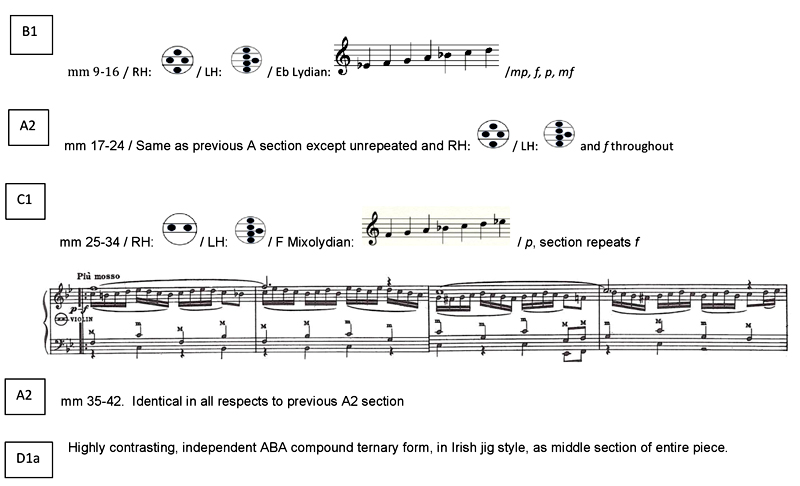

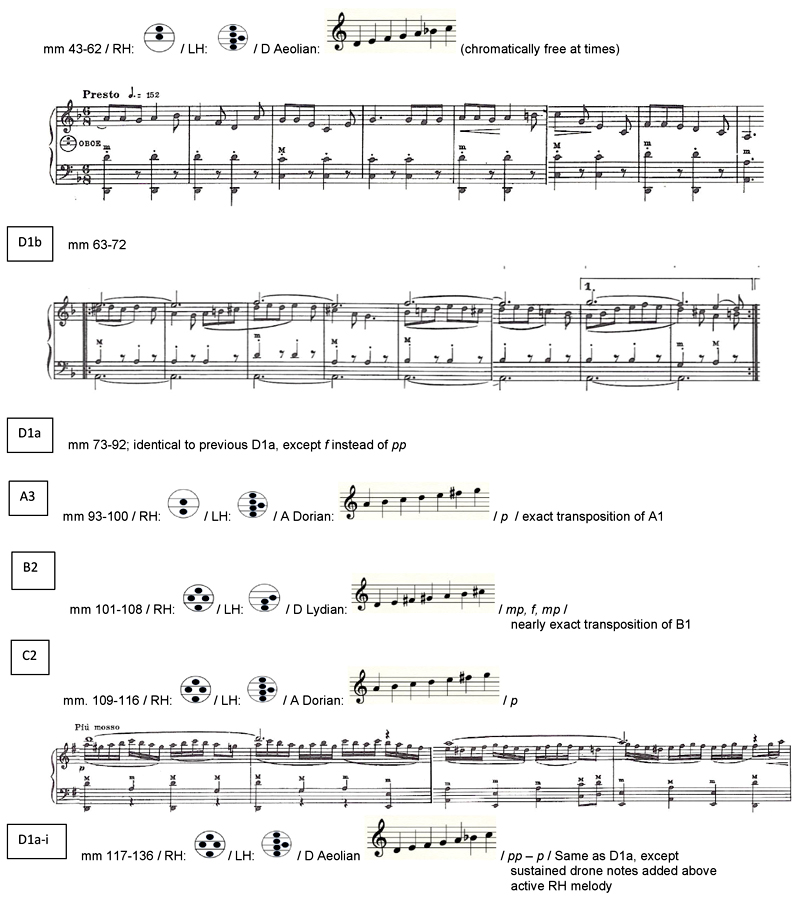
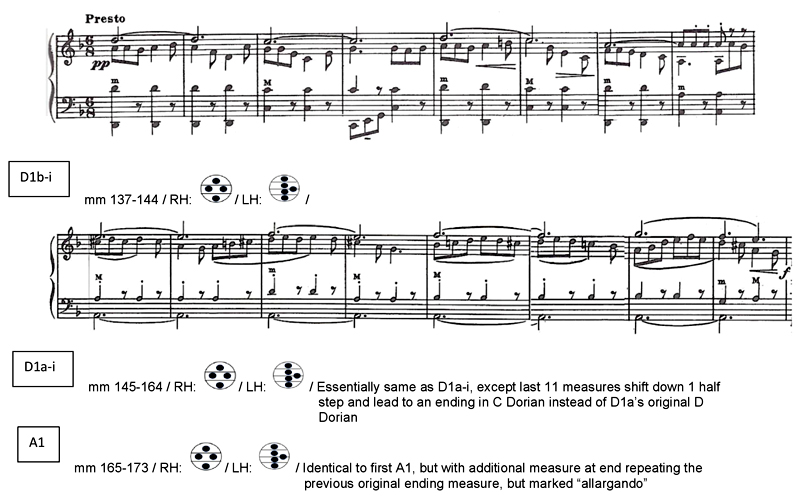
The Iridescent Rondo was published by Pietro Deiro Publications and Momac Music Company in 1960.
All three pieces discussed in this installment, along with Wallingford Riegger's Cooper Square, were premiered by Carmen Carrozza at Carnegie Hall on November 21, 1959, as part of the twenty-seventh season of the National Association for American Composers and Conductors.

Carmen Carrozza, Henry Cowell, Carlos Surinach, at NAACC concert, Carnegie Hall, November 21, 1959. Elsie Bennett photo album. |
New York Times critic John Briggs reported the next day that "Mr. Cowell's Iridescent Rondo made quaint, delightful and very effective use of modality, ... and Mr. Bennett's Four Nocturnes employed a sprightly jazz idiom, Mr. Surinach's Pavanna and Rondo was a big scale work that would be extremely effective in transcription for pipe organ” [the very opposite of what Surinach said about the accordion and the organ, as quoted above!].

Paul Creston, Carmen Carrozza, Henry Cowell, Robert Russell Bennett, Elsie Bennett, Carlos Surinach, Carnegie Hall, November 21, 1959. Elsie Bennett photo album. |
Two of the three works discussed in this writing, Pavana and Rondo and Iridescent Rondo, were recorded by William Schimmel on his 1980s LP Accordion Revisited (Finnander/Atlantic label) and may be heard on the AAA website’s CCC home page, as may Bennett’s Four Nocturnes, performed by Beverly Roberts Curnow.
*Cooper Square, originally discussed in the 1999 issue of the AAA Festival Journal. Riegger, like Cowell, opted to write an essentially tonal work for the AAA, as he occasionally did in other situations during his last years despite his normally being a devotee of atonal twelve-tone serialism across his entire career.
At the time of this article’s original publication in the 2000 AAA Festival Journal, a new commission by the American Accordionists' Association, Accordion Sonata, by Robert Baksa, was premiered by Eero Richmond at an Inoue Chamber Ensemble concert at Merkin Concert Hall (NYC) on May 31, 2000. Born in 1938, Baksa is an American composer who has written a great number of solos and chamber works in a highly inventive, but musically accessible, style. Audience response was quite enthusiastic. A live performance by Dr. McMahan may be heard on the AAA website’s CCC home page.
The AAA Composers’ Commissioning Committee welcomes donations from all those who love the classical accordion and wish to see its modern original concert repertoire continue to grow. The American Accordionists’ Association is a 501(c)(3) corporation. All contributions are tax deductible to the extent of the law. They can easily be made by visiting the AAA Store at http://www.ameraccord.com/cart.aspx which allows you to both make your donation and receive your tax deductible receipt on the spot.
For additional information, please contact Dr. McMahan at grillmyr@gmail.com
Upcoming Events2024 AAA 86th Festival,
July 12-14, 2024 West
Conshohocken, PA in the Philadelphia Area Carrozza Scholarship Fundraiser, September 15, 2024 Famee Furlane Club, NY. 2024 Elsie M. Bennett Accordion Composition Competition. Information and entry: Entry closing date, May 12, 2024. 2023 AAA 85th Anniversary Festival Daily ReportsJuly 12-16, 2023
2023 AAA Color Journal (47 pages) AAA History ArticlesHistorical Articles about the AAA by AAA Historian Joan Grauman Morse Music CommissionsOriginal works commissioned by the AAA since 1957
Recent articles: Download Composer's Guide to the Piano Accordion
AAA NewslettersLatest newsletters are now online. |